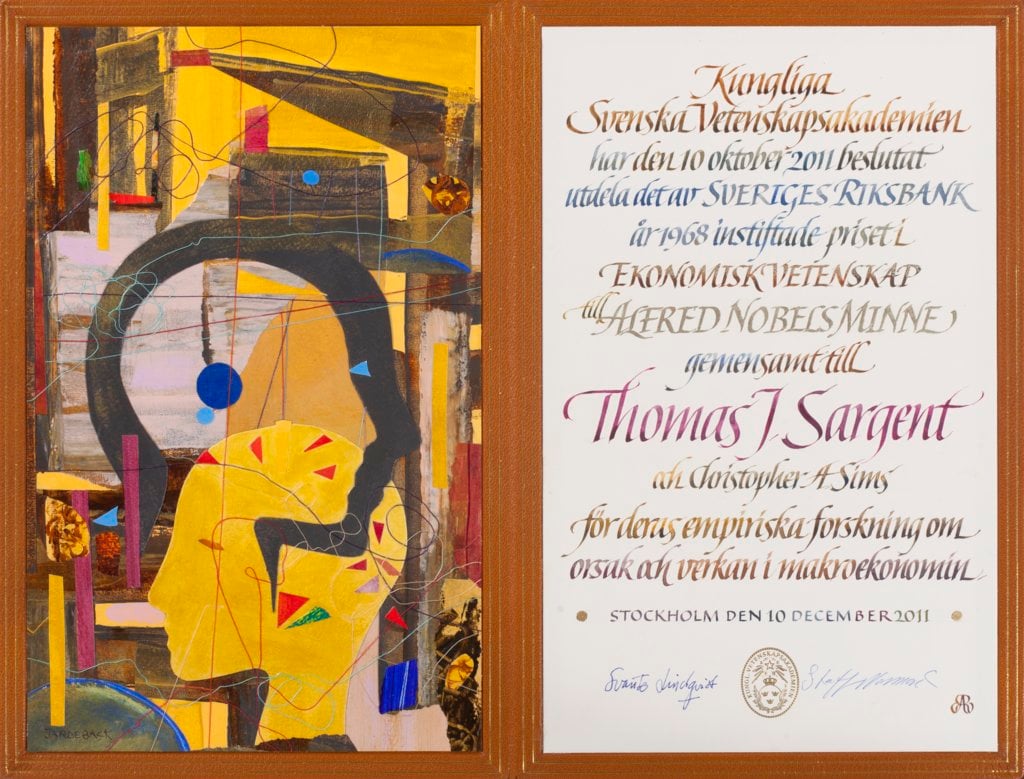In 1968, Sveriges Riksbank (Sweden’s central bank) established this prize in memory of Alfred Nobel, founder of the Nobel Prize. Here are some facts and figures regarding The Sveriges Riksbank Prize in Economic Sciences in Memory of Alfred Nobel, awarded from 1969 to 2024.
Number of economic sciences prizes
56 prizes in economic sciences have been awarded, every year since 1969.
26 prizes in economic sciences have been given to one laureate* only.
20 prizes in economic sciences have been shared by two laureates.
10 prizes in economic sciences have been shared between three laureates.
Number of economic sciences laureates
96 individuals have been awarded 1969-2024.
List of all economic sciences laureates
Youngest economic sciences laureate
The Sveriges Riksbank Prize in Economic Sciences in Memory of Alfred Nobel 2019
“for their experimental approach to alleviating global poverty”
Oldest economic sciences laureate
The Sveriges Riksbank Prize in Economic Sciences in Memory of Alfred Nobel 2007
“for having laid the foundations of mechanism design theory”
Female economic sciences laureates
Of the 96 individuals awarded the economics prize, 3 are women.
List of all female Nobel Prize laureates
Multiple economic sciences laureates
So far there are no multiple economic sciences laureates.
Multiple Nobel Prize laureates within other prize categories
No posthumous prizes in economic sciences
There have been no posthumous prizes in economic sciences. From 1974, the Statutes of the Nobel Foundation stipulate that a prize cannot be awarded posthumously, unless death has occurred after the announcement of the prize. Before 1974, the Nobel Prize has only been awarded posthumously twice: to Dag Hammarskjöld (Nobel Peace Prize 1961) and Erik Axel Karlfeldt (Nobel Prize in Literature 1931).
However, William Vickrey passed away just a few days after the announcement, and was not able to accept the prize in person.
Family economic sciences laureates
The medal for the prize in economic sciences
The medal in economic sciences was designed by Swedish artist and sculptor Gunvor Svensson-Lundqvist and shows the North Star emblem of the Royal Swedish Academy of Sciences.
Read more about the medal for the prize in economic sciences
The medal for the prize in economic sciences
The medal in economic sciences was designed by Swedish artist and sculptor Gunvor Svensson-Lundqvist and shows the North Star emblem of the Royal Swedish Academy of Sciences.
Read more about the medal for the prize in economic sciences
The diplomas
Each diploma is a unique work of art, created by foremost Swedish and Norwegian artists and calligraphers.

The prize amount
Alfred Nobel left most of his estate, more than SEK 31 million (today approximately SEK 2,2 billion) to be converted into a fund and invested in “safe securities.” The income from the investments was to be “distributed annually in the form of prizes to those who during the preceding year have conferred the greatest benefit to humankind.” The prize amount for the prize in economic sciences is the same as for the Nobel Prizes and is paid by the Riksbank.
The prize amount for 2024 is set at Swedish kronor (SEK) 11.0 million per full prize.
*Why “laureate”?
Why are the individuals awarded a prize in economic sciences called laureates? The word “laureate” refers to being signified by the laurel wreath. In Greek mythology, the god Apollo is represented wearing a laurel wreath on his head. A laurel wreath is a circular crown made of branches and leaves of the bay laurel (in Latin: Laurus nobilis). In Ancient Greece, laurel wreaths were awarded to victors as a sign of honour – both in athletic competitions and in poetic meets.
More facts on the Nobel Prizes
- Facts on the Nobel Prize in Physics
- Facts on the Nobel Prize in Chemistry
- Facts on the Nobel Prize in Physiology or Medicine
- Facts on the Nobel Prize in Literature
- Facts on the Nobel Peace Prize
- Facts on the prize in economic sciences
- Facts on all Nobel Prizes
First published 5 October 2009.